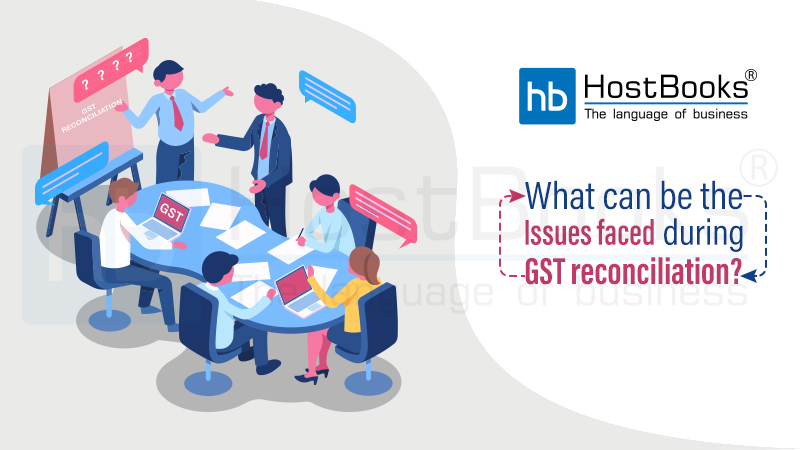What is GST Reconciliation and what are its common issues?

Under Goods and Services Tax (GST), reconciliation means recording every transaction that took place during a period while also ensuring that the data filed by the supplier matches with those of the recipients. This enables one to make sure that no sales or purchases are missing or wrongly reported in the GST returns.
In order to claim the input tax credit (ITC), the taxpayers have to reconcile their data with that of the vendors on a regular basis. Although the reconciliation process is simple, the necessity for the taxpayers to continuously keep track of any discrepancy or mismatches could be time-consuming.
What is GST Reconciliation?
The procedure of reconciliation and matching of GST returns is not new for taxpayers as it was prevalent in the previous VAT and excise regime. Before, the matching of data was done between the books of accounts and tax returns which was an easy task. In case of any discrepancy, the authorities would communicate the same to the taxpayer and accordingly further audits and scrutiny would be carried out.
However, under GST, reconciliation has gained much significance as it is associated with ITC claimed by businesses, which is again regularly monitored by the tax authorities. Furthermore, the taxpayer must reconcile their data on a regular basis with the data declared by their supplier.
How to do GST reconciliation?
You must start the reconciliation process within the GSTIN and then take it to the PAN level. For the entire FY 2017-18, the reconciliation of GST returns should be done across months. In addition, the amendments made in the current period of 2018-19 to GST returns of FY 2017-18 must be taken into consideration.
One of the most important components of the GST return is tax credit which holds greater relevance compared to any other component of GST returns. Unlike in the previous tax regime, now the accuracy of claims can be confirmed by taxpayers while filing GST returns (GSTR-2A) and take necessary action. Earlier, this function was carried out by tax authorities, usually during the processing of returns.
What are the common issues faced during GST reconciliation?
One of the major challenges during GST reconciliation is that the parties involved have a different method for their invoice numbers. This can make it harder for the implementation mechanism to find an exact match around invoice number. A powerful reconciliation tool could solve these problems while also easing the process of matching and reconciling GST returns data. Some of the major issues with the reconciliation between GST returns are listed below.
- The invoice numbers used by the purchaser to record transactions do not match with the seller’s invoices received in GSTR-2A. The reason could be that they both are following a different convention.
- The purchaser does business in multiple states, and the seller has raised invoice using anther GSTIN instead of the actual purchaser GSTIN.
- Both the purchaser and supplier have recorded invoices in different return periods.
- The invoice data recorded by the purchaser does not match with that of the seller. The reason behind this could be that the date of recording the invoices was different at both places. In this case, the purchaser might be at fault, at they should enter the date mentioned in the sales invoice.
- The invoice value for both supplier and purchaser differ by a minor value as both parties have a different practice of rounding off.
What are the causes for GST reconciliation mismatches?
Although there can be many reasons for the afore-mentioned discrepancies, some of the popular ones are as follows.
- The liability has been declared by the vendor, but the credit is not yet availed in the GST returns. Such credits should be utilized before the due date of September returns or Annual returns.
- Although businesses have utilized credit on supplies in the GST returns, the vendor has not declared liability on such procurements. In this case, the businesses should follow up with the vendor and make sure that the liability is declared. If delayed further, the risks of such credits being disallowed might increase.
- Differences between the liability declared by the vendor and the utilized credit. The reason for such mismatch should be identified and reconciled, for instance by issuing debit notes/credit notes.
- There can also be a mismatch in the details furnished such as GSTIN of the recipient/supplier, number and date of the invoice, etc. Amendments should be made in the GST returns of the month following the month in which mistakes were committed.
Conclusion
Therefore, the reconciliation of GST returns must be done appropriately on a regular basis. This can help you identify and declare necessary changes within the stipulated time. Additionally, you might also stay safe from the scrutiny notices issued by tax authorities.

Try HostBooks
SuperApp Today
Create a free account to get access and start
creating something amazing right now!















1 Comment
GST Reconciliation common errors article is very helpful.